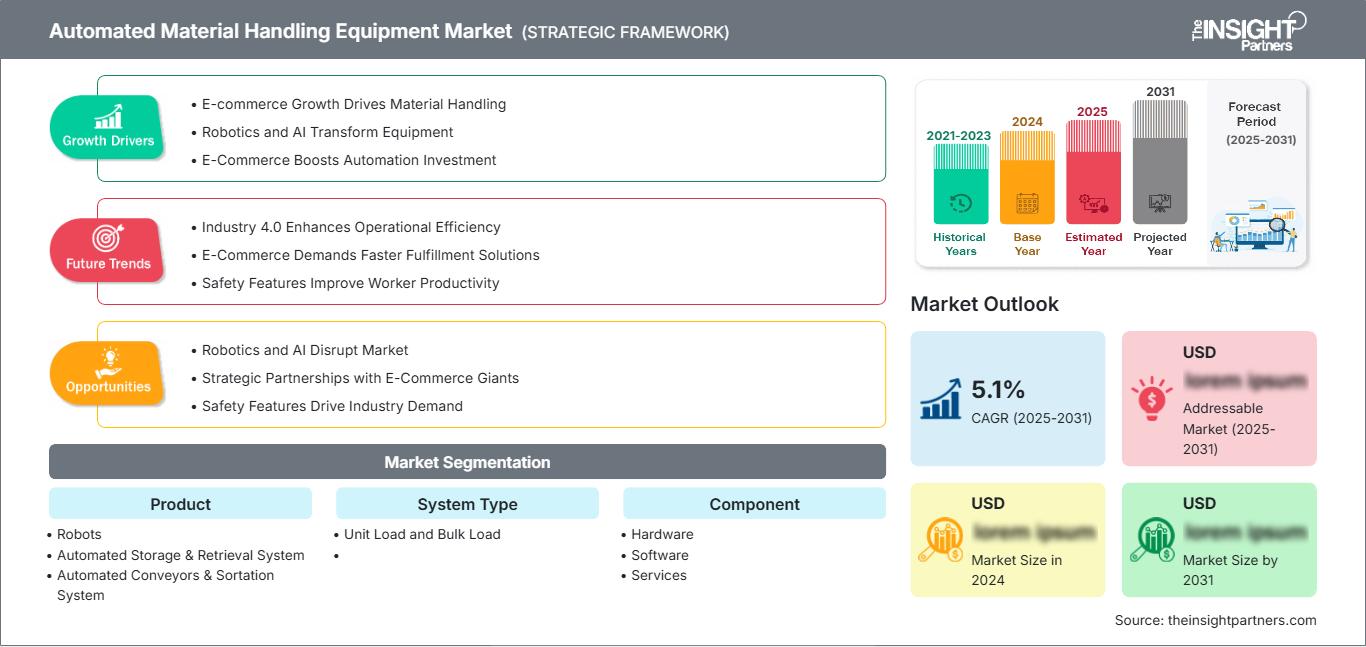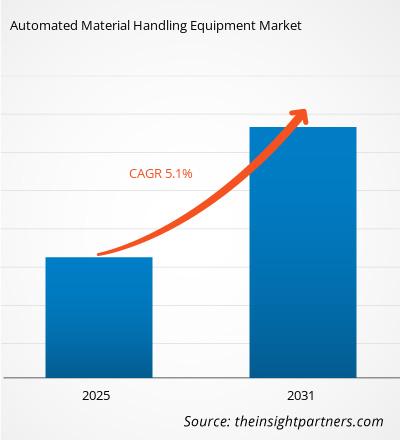Si prevede che il mercato delle attrezzature per la movimentazione automatizzata dei materiali registrerà un CAGR del 5,1% dal 2025 al 2031, con una dimensione del mercato in espansione da XX milioni di dollari nel 2024 a XX milioni di dollari entro il 2031.
Il rapporto sul mercato delle attrezzature per la movimentazione automatizzata dei materiali include un'analisi per prodotto, tipo di sistema, componente, funzione e settore. L'analisi globale è ulteriormente suddivisa a livello regionale e per i principali paesi. Il rapporto offre il valore in dollari USA per l'analisi e i segmenti sopra indicati.
Scopo del rapporto
Il rapporto sul mercato delle attrezzature per la movimentazione automatizzata dei materiali di The Insight Partners mira a descrivere il panorama attuale e la crescita futura, i principali fattori trainanti, le sfide e le opportunità. Ciò fornirà spunti a vari stakeholder aziendali, come:
- Fornitori/produttori di tecnologia: per comprendere le dinamiche di mercato in evoluzione e conoscere le potenziali opportunità di crescita, consentendo loro di prendere decisioni strategiche informate.
- Investitori: per condurre un'analisi completa delle tendenze in merito al tasso di crescita del mercato, alle proiezioni finanziarie del mercato e alle opportunità esistenti lungo la catena del valore.
- Organismi di regolamentazione: per regolamentare le politiche e le attività di controllo nel mercato con l'obiettivo di ridurre al minimo gli abusi, preservare la fiducia degli investitori e sostenere l'integrità e la stabilità del mercato.
Segmentazione del mercato delle apparecchiature per la movimentazione automatizzata dei materiali Prodotto
- Robot
- Sistema di stoccaggio e recupero automatizzato
- Sistema di trasporto e smistamento automatizzato
- Gru automatizzate
- Veicoli a guida automatizzata
Tipo di sistema
- Unità di carico e prodotti sfusi Caricamento
Componente
- Hardware
- Software
- Servizi
Funzione
- Conservazione
- Trasporto
- Assemblaggio
- Imballaggio
- Distribuzione
- Gestione dei rifiuti
Industria
- Automotive
- Elettronica
- Alimentare e Bevande
- E-commerce
- Aerospaziale
- Logistica
- Prodotti farmaceutici
Potrai personalizzare gratuitamente qualsiasi rapporto, comprese parti di questo rapporto, o analisi a livello di paese, pacchetto dati Excel, oltre a usufruire di grandi offerte e sconti per start-up e università
Mercato delle attrezzature per la movimentazione automatizzata dei materiali: Approfondimenti strategici

- Ottieni le principali tendenze chiave del mercato di questo rapporto.Questo campione GRATUITO includerà l'analisi dei dati, che vanno dalle tendenze di mercato alle stime e alle previsioni.
Fattori di crescita del mercato delle attrezzature per la movimentazione automatizzata dei materiali
- La crescita dell'e-commerce stimola la movimentazione dei materiali: la domanda in continua crescita del mercato per una movimentazione efficiente dei materiali nei magazzini è la forza trainante. A causa del crescente tasso di e-commerce in tutto il mondo, le aziende stanno adottando l'automazione per gestire elevati volumi di ordini. Questa tendenza verso l'automazione sta guidando in modo significativo la crescita del mercato di questa tecnologia, poiché le aziende stanno cercando di ottimizzare la propria supply chain e ottenere il massimo risparmio possibile sui costi operativi, come evidenziato da recenti rapporti di analisi di mercato.
- Robotica e intelligenza artificiale trasformano le attrezzature: le attrezzature per la movimentazione dei materiali a livello globale si stanno trasformando con l'integrazione di robotica e intelligenza artificiale. Tali progressi stanno plasmando le tendenze del mercato, guidando la domanda di operazioni molto più efficienti verso cui le industrie si stanno orientando.
- L'e-commerce stimola gli investimenti nell'automazione: è chiaro che la rapida ascesa del settore dell'e-commerce ha avuto un impatto significativo sul mercato delle attrezzature per la movimentazione automatizzata dei materiali. Con l'aumento degli ordini online, le aziende investono in sistemi di automazione per soddisfare la domanda nei tempi previsti. Recenti report di mercato indicano che gli operatori del mercato globale hanno aumentato del 15% i loro investimenti in soluzioni di automazione per la logistica e il magazzino. Questo sta modificando le dimensioni del mercato, generando al contempo una crescita in regioni chiave in tutto il mondo.
Trend futuri del mercato delle attrezzature per la movimentazione automatizzata dei materiali
- L'Industria 4.0 migliora l'efficienza operativa: le tecnologie dell'Industria 4.0 come l'IoT e l'analisi dei big data stanno trasformando l'AMHE, nel senso che la manutenzione predittiva e l'efficienza operativa vengono ottimizzate con l'aiuto di queste tecnologie. Un'indagine del 2022 ha mostrato che oltre il 50% delle aziende che utilizzano l'AMHE ha confermato una migliore supply chain prendendo decisioni basate sui dati. In tali dinamiche di mercato, le aziende si trovano a dover cambiare radicalmente il modo in cui potrebbero utilizzare le risorse e ridurre al minimo i tempi di inattività.
- L'e-commerce richiede soluzioni di evasione ordini più rapide: l'e-commerce è un mercato in rapida crescita, e continua a crescere, che stimola l'innovazione nell'AMHE, soprattutto per l'ultimo miglio. Le strategie di mercato si concentrano sull'efficienza e la velocità nei centri di evasione ordini. Un recente studio evidenzia che oltre il 60% delle aziende di logistica si è già integrato nell'AMHE per semplificare le proprie catene di approvvigionamento. Un'analisi PEST rivela che il cambiamento del comportamento dei consumatori verso lo shopping online ha spinto le aziende a investire in soluzioni di movimentazione avanzate. Questa tendenza posiziona l'AMHE come necessaria per soddisfare le crescenti aspettative dei consumatori.
- Le caratteristiche di sicurezza migliorano la produttività dei lavoratori: pertanto, con l'aumento dei problemi di sicurezza nei magazzini, l'urgenza di design ergonomici si fa sempre più pressante nell'AMHE. Le aziende leader stanno sviluppando attrezzature che riducono lo stress dei lavoratori e i casi di incidenti. Secondo un recente sondaggio, si stima che il 70% delle aziende che implementano misure di sicurezza abbia ridotto significativamente gli infortuni sul lavoro. Un'altra dinamica di mercato riflette chiaramente come questi problemi di sicurezza siano conformi alle normative e migliorino la produttività dei dipendenti. L'analisi SWOT indica che dare importanza fondamentale all'ergonomia può fornire un vantaggio competitivo sul mercato.
Opportunità di mercato per le attrezzature di movimentazione automatizzata dei materiali
- Robotica e intelligenza artificiale rivoluzionano il mercato: i progressi nella robotica e nelle tecnologie basate sull'intelligenza artificiale stanno rivoluzionando il mercato della movimentazione automatizzata dei materiali, ovviamente, soprattutto in Europa e Asia. L'analisi competitiva rivela che le aziende leader nella ricerca e sviluppo rappresentano una quota considerevole del mercato. Le aziende che trarranno vantaggio da questi sviluppi nel panorama tecnologico trarranno vantaggio da risparmi sui costi, miglioramenti della sicurezza e un vantaggio competitivo in tutto il mondo.
- Partnership strategiche con i giganti dell'e-commerce: la partnership strategica con i più grandi siti di e-commerce rappresenta un'altra grande opportunità di crescita nel mercato della movimentazione automatizzata dei materiali. Con i rivenditori online destinati a continuare a crescere, le aziende di logistica puntano a un maggiore livello di automazione nelle loro attività. L'analisi competitiva suggerisce che la partnership con i giganti dell'e-commerce nel campo dell'automazione contribuirà anche a questo, in termini di maggiore efficienza e velocità. Questa tendenza sta cambiando il volto del settore, consentendo alle aziende di applicare meglio la tecnologia per rispondere alle mutevoli esigenze e desideri dei consumatori in diverse aree geografiche.
- Le funzionalità di sicurezza stimolano la domanda del settore: per quanto riguarda la manodopera, la sicurezza è sempre un'esigenza importante per quanto riguarda l'automazione della movimentazione dei materiali ed è fondamentale nel settore, il che alimenta ulteriormente la domanda di funzionalità di sicurezza avanzate. Secondo nuove statistiche, le aziende che investono in dispositivi di sicurezza automatizzati, inclusi i sistemi anticollisione, riducono gli incidenti sul lavoro del 25%. L'analisi competitiva dimostra che le aziende che si concentrano sulla sicurezza non solo proteggono la sicurezza dei dipendenti, ma migliorano anche la loro efficienza operativa. L'enfasi sulla sicurezza rappresenta un buon clima per la crescita del settore, soprattutto in ambienti altamente pericolosi come magazzini o impianti di produzione.
Approfondimenti regionali sul mercato delle attrezzature per la movimentazione automatizzata dei materiali
Le tendenze regionali e i fattori che influenzano il mercato delle attrezzature per la movimentazione automatizzata dei materiali durante il periodo di previsione sono stati ampiamente spiegati dagli analisti di The Insight Partners. Questa sezione illustra anche i segmenti e la geografia del mercato delle attrezzature per la movimentazione automatizzata dei materiali in Nord America, Europa, Asia-Pacifico, Medio Oriente e Africa, America meridionale e centrale.
Ambito del rapporto di mercato sulle attrezzature per la movimentazione automatizzata dei materiali
| Attributo del rapporto | Dettagli |
|---|---|
| Dimensioni del mercato in 2024 | US$ XX million |
| Dimensioni del mercato per 2031 | US$ XX Million |
| CAGR globale (2025 - 2031) | 5.1% |
| Dati storici | 2021-2023 |
| Periodo di previsione | 2025-2031 |
| Segmenti coperti |
By Prodotto
|
| Regioni e paesi coperti | Nord America
|
| Leader di mercato e profili aziendali chiave |
|
Densità degli operatori del mercato delle attrezzature per la movimentazione automatizzata dei materiali: comprendere il suo impatto sulle dinamiche aziendali
Il mercato delle attrezzature per la movimentazione automatizzata dei materiali è in rapida crescita, trainato dalla crescente domanda degli utenti finali, dovuta a fattori quali l'evoluzione delle preferenze dei consumatori, i progressi tecnologici e una maggiore consapevolezza dei vantaggi del prodotto. Con l'aumento della domanda, le aziende stanno ampliando la propria offerta, innovando per soddisfare le esigenze dei consumatori e sfruttando le tendenze emergenti, alimentando ulteriormente la crescita del mercato.

- Ottieni il Mercato delle attrezzature per la movimentazione automatizzata dei materiali Panoramica dei principali attori chiave
Punti di forza
- Copertura completa: il rapporto analizza in modo esaustivo prodotti, servizi, tipologie e utenti finali del mercato delle attrezzature per la movimentazione automatizzata dei materiali, offrendo una panoramica olistica.
- Analisi degli esperti: il rapporto è redatto sulla base della conoscenza approfondita di esperti e analisti del settore.
- Informazioni aggiornate: il rapporto garantisce la pertinenza aziendale grazie alla copertura di informazioni e dati recenti.
- Opzioni di personalizzazione: questo rapporto può essere personalizzato per soddisfare le esigenze specifiche del cliente e adattarsi in modo appropriato alle strategie aziendali.
Il rapporto di ricerca sul mercato delle attrezzature per la movimentazione automatizzata dei materiali può quindi contribuire a guidare il percorso di decodificazione e comprensione dello scenario del settore e delle prospettive di crescita. Sebbene possano esserci alcune valide preoccupazioni, i vantaggi complessivi di questo rapporto tendono a superare gli svantaggi.
- Analisi storica (2 anni), anno base, previsione (7 anni) con CAGR
- Analisi PEST e SWOT
- Valore/volume delle dimensioni del mercato - Globale, Regionale, Nazionale
- Industria e panorama competitivo
- Set di dati Excel
Report recenti
Testimonianze
Motivo dell'acquisto
- Processo decisionale informato
- Comprensione delle dinamiche di mercato
- Analisi competitiva
- Analisi dei clienti
- Previsioni di mercato
- Mitigazione del rischio
- Pianificazione strategica
- Giustificazione degli investimenti
- Identificazione dei mercati emergenti
- Miglioramento delle strategie di marketing
- Aumento dell'efficienza operativa
- Allineamento alle tendenze normative






















 Ottieni un campione gratuito per - Mercato delle attrezzature per la movimentazione automatizzata dei materiali
Ottieni un campione gratuito per - Mercato delle attrezzature per la movimentazione automatizzata dei materiali